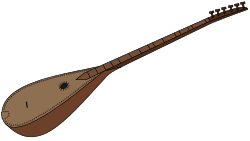Šargija
 | |
| Classification | |
|---|---|
| Related instruments | |
The šargija (Cyrillic: Шаргија, Albanian: Çallgi, Sharki) is a plucked, fretted long necked chordophone used in the folk music of various Balkan countries, including Bosnia and Herzegovina, Croatia, Albania, Kosovo and Serbia.
The šargija originated in Bosnia and Herzegovina during the rule of Ottoman Empire, and is played by Bosniaks, Albanians, Serbs and Croats. Its original four strings have been increased to six or even seven. The šargija usually accompanies the violin, and has a jangling sound, similar to the Turkish saz. The sharki (or sargija) is a similar instrument as the two-string qiftelia, but with more strings and looking more like a primitive saz. Spelling is sometimes: sarkia or sharki or sharkia. Usually there are three courses of metal strings. The frets are often inlaid metal frets, in a non-western pattern. Body could be made from separate staves, or carved from one piece of wood.
Use
The šargija is used by the Bosnians in Bosnian root music. The tamburica/tambura is mostly associated with Croats and some Serbs.
Sources
- Atlas of Plucked Instruments
- JazzStudied Website — San Diego State University